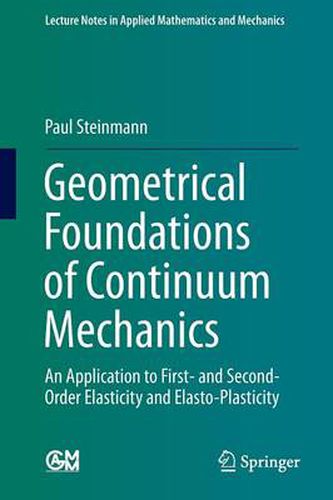Geometrical Foundations of Continuum Mechanics: An Application to First- and Second-Order Elasticity and Elasto-Plasticity
Paul Steinmann

Geometrical Foundations of Continuum Mechanics: An Application to First- and Second-Order Elasticity and Elasto-Plasticity
Paul Steinmann
This title is printed to order. This book may have been self-published. If so, we cannot guarantee the quality of the content. In the main most books will have gone through the editing process however some may not. We therefore suggest that you be aware of this before ordering this book. If in doubt check either the author or publisher’s details as we are unable to accept any returns unless they are faulty. Please contact us if you have any questions.
This book illustrates the deep roots of the geometrically nonlinear kinematics of
generalized continuum mechanics in differential geometry. Besides applications to first-
order elasticity and elasto-plasticity an appreciation thereof is particularly illuminating
for generalized models of continuum mechanics such as second-order (gradient-type)
elasticity and elasto-plasticity.
After a motivation that arises from considering geometrically linear first- and second-
order crystal plasticity in Part I several concepts from differential geometry, relevant
for what follows, such as connection, parallel transport, torsion, curvature, and metric
for holonomic and anholonomic coordinate transformations are reiterated in Part II.
Then, in Part III, the kinematics of geometrically nonlinear continuum mechanics
are considered. There various concepts of differential geometry, in particular aspects
related to compatibility, are generically applied to the kinematics of first- and second-
order geometrically nonlinear continuum mechanics. Together with the discussion on
the integrability conditions for the distortions and double-distortions, the concepts
of dislocation, disclination and point-defect density tensors are introduced. For
concreteness, after touching on nonlinear fir
st- and second-order elasticity, a detailed
discussion of the kinematics of (multiplicative) first- and second-order elasto-plasticity
is given. The discussion naturally culminates in a comprehensive set of different types
of dislocation, disclination and point-defect density tensors. It is argued, that these
can potentially be used to model densities of geometrically necessary defects and the
accompanying hardening in crystalline materials. Eventually Part IV summarizes the
above findings on integrability whereby distinction is made between the straightforward
conditions for the distortion and the double-distortion being integrable and the more
involved conditions for the strain (metric) and the double-strain (connection) being
integrable.
The book addresses readers with an interest in continuum modelling of solids from
engineering and the sciences alike, whereby a sound knowledge of tensor calculus and
continuum mechanics is required as a prerequisite.
This item is not currently in-stock. It can be ordered online and is expected to ship in 7-14 days
Our stock data is updated periodically, and availability may change throughout the day for in-demand items. Please call the relevant shop for the most current stock information. Prices are subject to change without notice.
Sign in or become a Readings Member to add this title to a wishlist.


